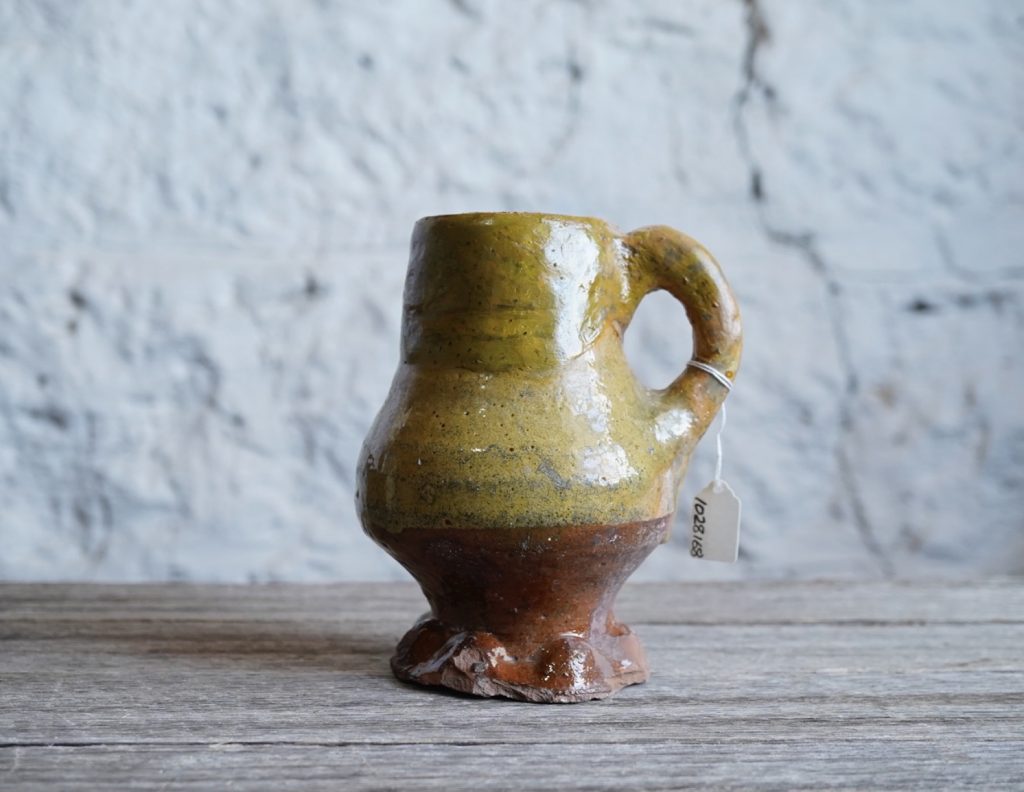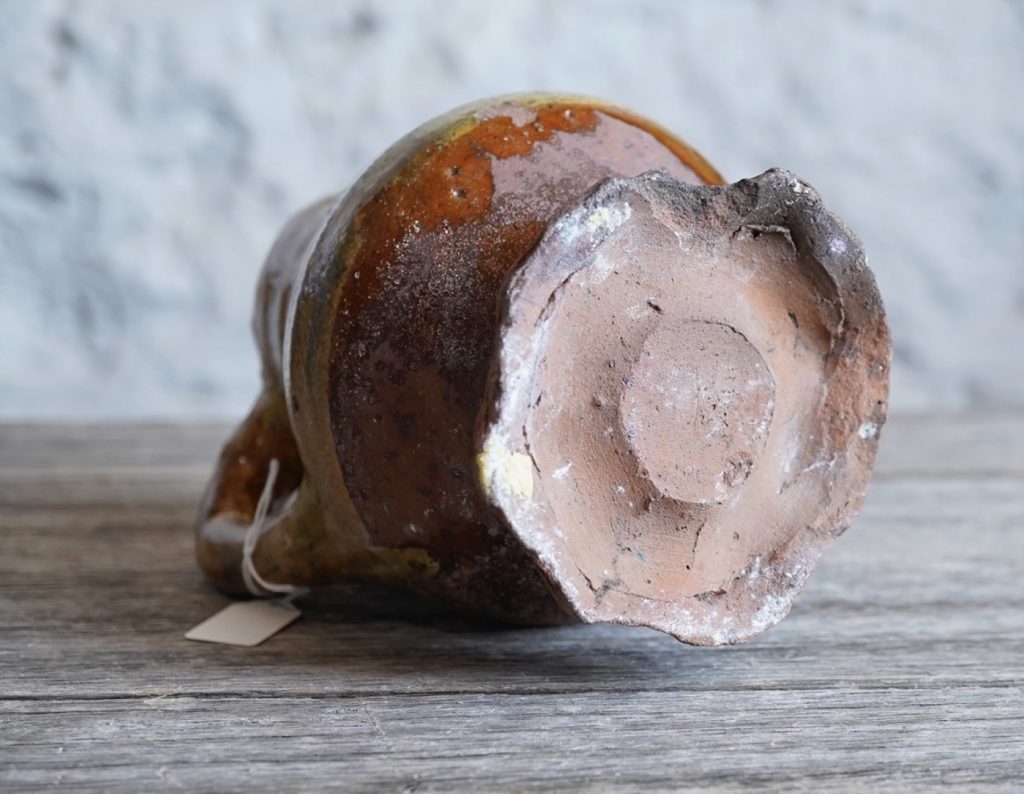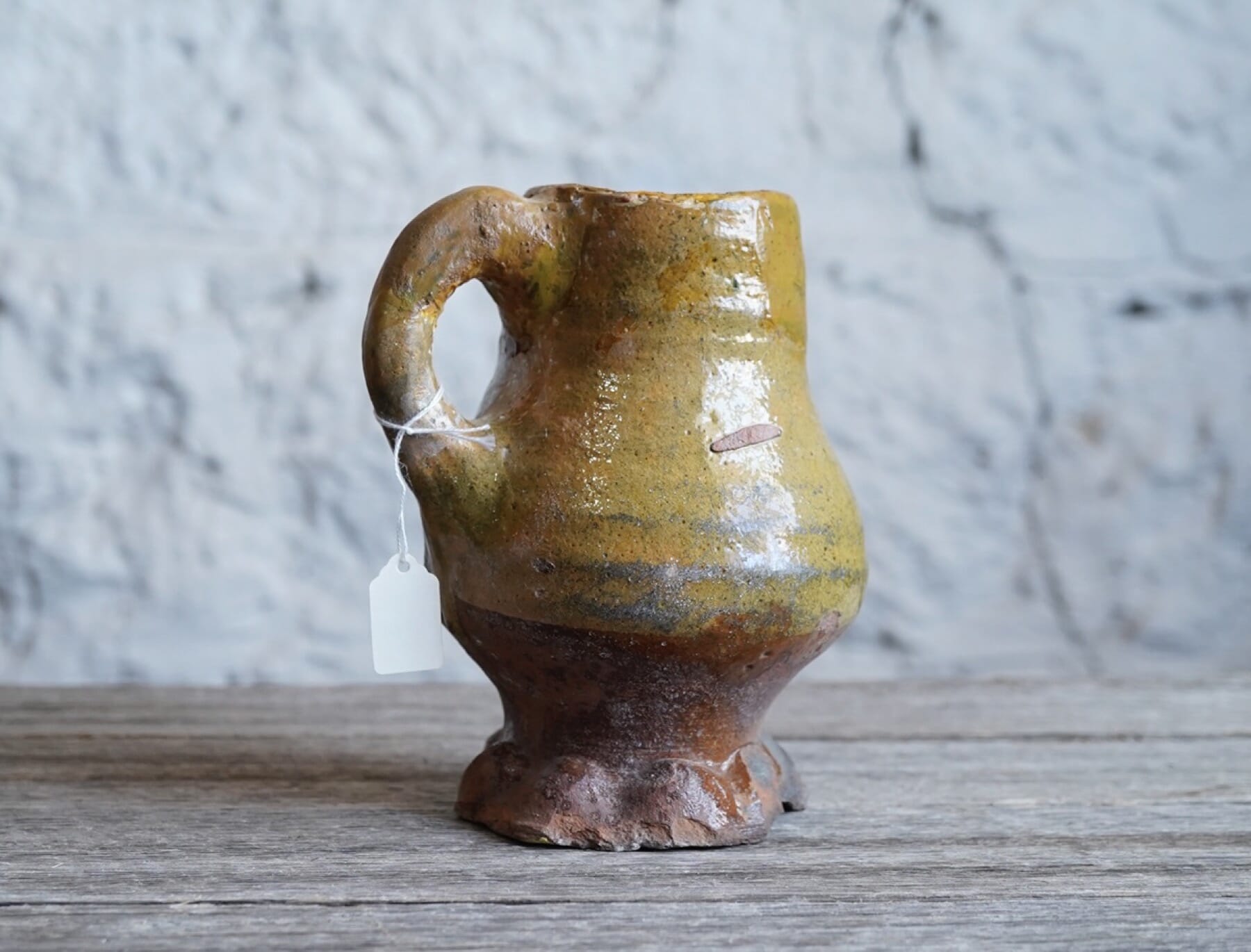
We’re used to ‘rip-offs’, where popular brand shoes & sunglasses are copied & sold for a fraction the price. An interesting Medieval drinking mug just in at Moorabool is proof it has been going on forever!
This interesting Medieval drinking mug recently came in to stock at Moorabool . It has all the characteristics of an English Medieval piece, well-known from the archaeological excavations of Medieval Kilns in North Yorkshire & Somerset, refuse in places like London and York. There are often thousands of stoneware shards found – and the occasional complete example – and this volume is due to their extremely robust nature. Known as ‘Stoneware’, it is a very high-fired ceramic which for all intents & purposes turns to a stone-like substance in the kiln. It doesn’t decay or even stain easily, and can only be destroyed by physical means such as shattering against something harder. As the refuse heaps most broken household discards ended up on contained much softer rubbish, these pieces often appear with just the initial damage they received that caused them to be thrown away – with the broken edge still sharp. Even when a piece has been in the Thames river for 500 years, tossing in the current, it can still have good shape – although any glaze is softer, and often worn away. I spent my spare time in my London days down on the banks of the Thames, picking up these amazing shards from so long ago, and have a prized collection here in our Reference Collection at Moorabool.


But there is something odd about this English piece of pottery, which nagged at me to have a second look: it actually looks more German, like the Rhinish stonewares of Raeren and Sieburg which were imported into Medieval England in vast quantities. So what makes it English?
The body is the main indicator, and secondly, the glaze that sits on it. The body is a light pinkish colour, burning brown in places. This is sometimes found in the ‘Border Wares’ of Northern Yorkshire, or the Somerset potteries to the west, and combined with a mottled yellow glaze with green spotting, it conforms to documented English Medieval types.
The decoration is perhaps a little fancier than most examples, achieved by dipping it in a tub of tinted lead-glaze, with just the top half done in the yellow, the base carefully painted in a clear glaze, which brings out the iron-rich red hue of the clay.

The Germans didn’t utilize lead glazes in this manner, but instead developed the beautiful lustrous salt-glaze, achieved by throwing a salty water solution into a super-hot firing kiln; this salt (sodium chloride) vaporizes and reacts with the steam produced to form a new compound – hydrogen chloride – which forms a bond with any silica in the clay body of the pots. Any Iron – which causes the reddish-brown colour of the clay – is a bonus, as it acts as a ‘flux’ to speed up the process, and also gives the rich brown colour to the result. This was the method all the 15th-17th century pots imported from Germany to England were finished in, making identifying shards from excavations in England simpler to identify. In the mid 17th century, the Salt Glaze technology comes to London, and then elsewhere including Yorkshire, and it becomes a little more difficult to define origin.

Our example is therefore a Medieval ‘hybrid’. The shape is German, with a ‘thumbed’ base very much like the imported German pieces of the 14th-15th century . This was the usual method of finishing the base of the wheel-turned German stoneware mugs, and serves a function: it raises the base of the pot off the surface it sits on, meaning it is less likely to shatter the main body if placed down carelessly. The main pot was thrown on a wheel, and then a small loop of clay added to the base using the thumb & forefinger, creating a ruffled spreading foot we call ‘thumbed’.

While most English Medieval pottery has a simple flat base, there are examples of English Border Wares imitating this method of thumbing – but they are looking on it more as a decorative element, not as a functional structure. These pieces have had a thumb involved, but it has merely pushed in a groove multiple times around the foot, causing it to spread the clay in a pie-crust pattern, entirely from the outside. The German method pushes ‘out’, and the English method pushes ‘in’. Our example is a surprisingly accurate replica of the German ‘push-out’ idea, on an English pot.


Searching through the literature on English Medieval Pottery, there are multiple examples of the before mentioned push-in thumbing, but finding a push-out was very difficult; eventually, I tracked down an example in the collection of the Museum of London. In Pierce & Vince ‘Surrey Whitewares’ (p72) this ‘small round drinking jug’ is described as ‘…without parallel…in excavated pottery from London’. In shape it resembles the Kingston-type small rounded forms, but differs from it in detail. It appears to have been made as a copy of 14th-century German drinking jugs …. pronounced throwing marks can be seen around the body, and the base is thumbed in a manner that recalls the suggested German prototypes’.
It’s great to find another attribution for a German source for the design, and the unparalleled classification makes it an extreme rarity.


A further example is interesting, coming from the Somerset town of Donyatt. In the definitive book ‘Excavations in the Donyatt Potteries’, there is an example illustrated next to a German one, with the notes explaining they were found together in the same refuse heap,in the Somerset town of Taunton in the 1977 excavations of ‘Kennedy’s Yard’. As it is a line drawing, we cannot compare the surface detailing, but it bears a close resemblance to our example. We are familiar with Donyatt wares from the 18th-19th century, when they were prolific producers of slip-glaze & ornately decorated curios like money boxes, often inscribed & dated. Comparing the glazes to examples in our Reference Collection in Geelong shows a close similarity in materials – the clay is lower-fired in our 19th century money box examples, but contains the iron-red staining evident in the Medieval mug. The glaze is referred to in the literature as ‘Amber glaze with copper green flecking’ – copper oxide was splashed through the glaze, and is recorded in the medieval period, becoming very common later, giving the green highlights to the distinct slip glaze that developed. And under the heading ‘Thumbed bases’, it states ‘Thumbed bases, so typical a feature in medieval pottery are found in both 14th- and 16th century Donyatt jugs’. When looking at the referenced archaeological shards from the kiln sites. we find a host of the ‘push-in’ thumb decoration to the feet of vessels – but only one single ‘out-pushing’ example that would raise the vessel on a rippled base – as seen in our example, and the German products. This shard exhibits ‘patchy amber to green glaze’ – like our example- and is apparently a very scarce type of foot at Donyatt.

Our case for this being a 14th-15th century Donyatt Pottery jug/mug is strong!
See the other recently released German Stoneware examples on our blog post here >>
See the English mug on the website below:
Further Reading:
German Stoneware 1200-1900 David Gaimster, British Museum 1997
Excavations in the Donyatt Potteries R. Coleman-Smith & T. Pearson, Phillimore & Co 1988
Surrey Whitewares Jacqueline Pearce & Alan Vince Museum of London 1988

